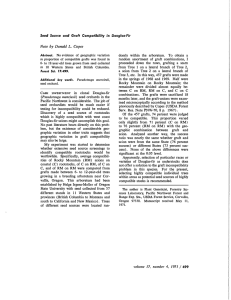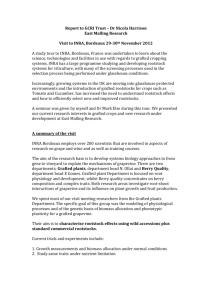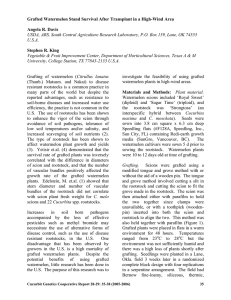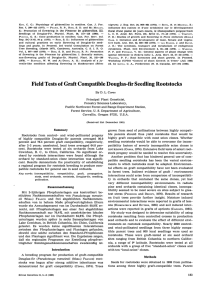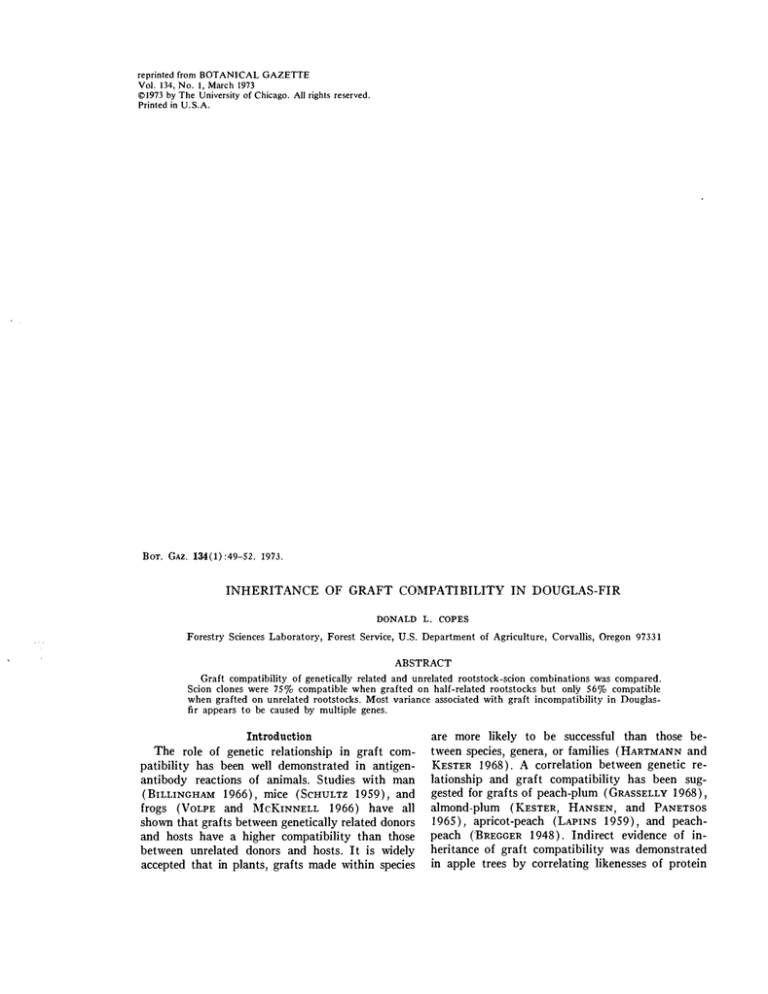
reprinted from BOTANI CAL GAZETTE I, March 1973 University of Chicago. All rights reserved. Printed in U.S.A. Vol. 134, No.
©1973 by The
BoT. GAz. 134(1) :49-52. 1973.
INHERITANCE OF GRAFT COMPATIBILITY IN DOUGLAS-FIR
DONALD L. COPES
Forestry Sciences Laboratory, Forest Service, U.S. Department of Agriculture, Corvallis, Oregon 97331
ABSTRACT
Graft compatibility of genetically related and unrelated rootstock-scion combinations was compared.
Scion clones were 75% compatible when grafted on half-related rootstocks but only 56% compatible
when grafted on unrelated rootstocks. Most variance associated with graft incompatibility in Douglas­
fir appears to be caused by multiple genes.
Introduction
The role of genetic relationship in graft com­
patibility has been well demonstrated in antigen­
antibody reactions of animals. Studies with man
(BILLINGHAM 1966), mice (SCHULTZ 1959), and
frogs (VoLPE and McKINNELL 1966) have all
shown that grafts between genetically related donors
and hosts have a higher compatibility than those
between unrelated donors and hosts. It is widely
accepted that in plants, grafts made within species
are more likely to be successful than those be­
tween species, genera, or families (HARTMANN and
KESTER 1968). A correlation between genetic re­
lationship and graft compatibility has been sug­
gested for grafts of peach-plum (GRASSELLY 1968),
almond-plum (KESTER, HANSEN, and PANETSOS
1965), apricot-peach (LAPINS 1959), and peach­
peach (BREGGER 1948). Indirect evidence of in­
heritance of graft compatibility was demonstrated
in apple trees by correlating likenesses of protein
BOTANICAL GAZETTE
50
spectra of rootstock and scion with biological data
for graft compatibility. Stocks and scions with
similar protein spectra were more likely to form
compatible unions than were those .with unlike
spectra (SAFONOV and VEIDENBERG 1969). Little
else is known of gene control of compatibility re­
sponse in plant grafts. This preliminary study was
started to explore the nature of gene control over
graft compatibility in the conifer Douglas-fir
(Pseudotsuga menziesii).
Material and methods
Genetic effect on graft compatibility in Douglas­
fir was investigated in two different experiments.
The objective of experiment 1 was to determine
whether more compatible grafts resulted when the
scion and rootstock were genetically related than
when the scion and rootstock were unrelated. The
objective of experiment 2 was to determine the
compatibility of seedlings grafted on rootstocks
which were compatible with either one or both
parents of the seedlings.
In· experiment 1, scion clones were grafted on re­
lated and unrelated rootstocks. Related rootstocks
were obtained by growing seedlings from crossed
and wind-pollinated seed collected from the scion
clones. The rootstocks received half their genes
from the scion clones; thus, they are termed "half­
related" throughout this report. Unrelated root­
stocks were random nursery stock from hundreds
of different parents. Some scion clones served as
male and female parents of the rootstocks, so that
maternal and paternal influence on compatibility
could be tested. The parents were approximately
50- to 80-year-old trees. Seedlings from each cross
were grafted with scions from each parent when
they were 1 year old. A cleft graft was made on the
terminal of each tree. Unrelated rootstocks were
grafted with the same clones when the rootstocks
were 2 years old. All grafting was done in a green­
house on potted trees. Compatibility was deter­
mined by anatomical test 18 months after grafting
(CoPES 1967). The test involves the presence (in­
compatible) or absence (compatible) of character­
istic wound areas in the xylem tissues connecting
the stock and scion. No autoplastic grafts were
made because a past study had already demon­
strated complete compatibility of such grafts
(COPES 1968).
The next step for experiment 2 should have been
testing the parental clones on rootstocks grown
from self-pollinated seeds. Such seedlings would
have all genes in common with the scion clone and
could have been termed "whole-related." Unfortu­
nately, the Douglas-fir trees studied were highly
[MARCH
self-sterile and few self-pollinated seedlings were
available for grafting; therefore, in experiment 2,
whole-related rootstocks were simulated through
judicious selection. Unrelated rootstocks that were
tested and found compatible with both parents of
the seedlings were selected as simulated whole­
related rootstocks. It was hoped that they had
compatibility factors analogous to those found in
actual whole-related offspring. The rootstocks were
10- to 12-year-old trees growing in a field planta­
tion. Terminals from 1-year-old seedlings ( experi­
ment 1 rootstocks) were collected for scions and
were grafted upon the selected rootstocks. Cleft
grafts were made on the tips of the lateral branches.
As a control, scions from seedlings of each parent­
age were grafted upon rootstocks which were com­
patible with only one of the seedling's two parents.
Compatibility was determined by anatomical test
18 months after grafting (CoPES 1967).
Results and discussion
Except for the highly aberrant parentage clone
14, experiments 1 and 2 showed that increased
compatibility resulted from grafting genetically re­
lated rootstocks and scions. In experiment 1, scion
clones grafted upon half-related rootstocks aver­
aged 19% (75 o/o vs. 56%) more compatible grafts
than the same clones grafted upon unrelated root­
stocks (table 1). The 19% gain probably occurred
because the scion clones had more genes in common
with half-related rootstocks than with unrelated
rootstocks.
In experiment 2, an even higher compatibility
resulted with simulated whole-related rootstocks
than was found in experiment 1 with half-related
rootstocks. In experiment 2, 91% of the grafts were
compatible when seedling families were grafted
upon rootstocks which were compatible with both
parents, while only 50% were compatible when
grafted on rootstocks which were compatible with
only one parent (table 2).
Clone 14 probably deserved special genetic study
because of its obvious atypical behavior in rejecting
related rootstocks. In both studies it consistently
rejected a high percentage of grafts in which its
genes were present in both scion and rootstock. It
was distinctly more compatible when either the
rootstock or the scion contained no clone 14 genes.
Treatment differences were highly significant in
both experiments when clone 14 seedlings were ex­
cluded from an unweighted analysis of variance
(F = 20.94** for experiment 1 and 17.66** for
experiment 2). Inclusion of clone 14 seedlings in
the analysis still resulted in highly significant dif­
COPES-INHERITANCE OF GRAFT COMPATIBILITY
1973]
51
TABLE 1 AVERAGE
COMPATIBILITY OF
( RELATED
12
CLONES GRAFTED ON RELATED AND UNRELATED ROOTSTOCKS ROOTSTOCKS HAD HALF THEIB GENES IN COMMON WITH THE SCION CLONES )
o/o GRAFTS COMPATIBLE
WHEN SCION CLONE IS GRAFTED ON:
PARENTAGE OF RELATED
SEEDLING ROOTSTOCKS
SciON CLONE
6 . .
8
24
5 . .
.
.
.
.
.
.
.
·
·
·
·
·
.
.
.
165
. ... . .
.
.
.
·
·
·
·
·
·
·
·
·
·
·
·
·
·
·
·
·
.
.
.
.
.
.
.
.
.
.
..
.. .
.
.
.
.
.
.
.
·
·
·
·
. .. ...
.
.
.
14 . .. . . . . .
16 . . .. .. . .
. .
60 ..
. ..
..
9 . .
34
.. ..
.. .
160
..
..
..
... .
175 . . .
.
.
.
.
.
.
.
.
.
.
.
.
.
.
.
.
.
.
.
.
.
.
.
.
.
.
.
.
.
.
.
.
.
.
.
.
.
.
.
.
.
.
.
.
.
.
.
.
.
.
.
.
.
.
.
.
.
.
.
.
.
.
.
.
.
.
.
.
..
Weighted average
aN
.
.
.
.
.
.
Unrelated
rootstock
o/o
6 X 5, 6 X 24, 6 X 165
8 X 5, 8 X 165, 8 X 16
24 X 6, 24 X 165
5 X 6, 5 X 8, 5 X 16, 5 X 165, 5 X windb
165 X 6, 165 X 8, 165 X 24,
165 X 60, 165 X 9, 165 X 14,
165 X wind
14 X 16, 165 X 14, 14 X wind
16 X 5, 16 X 8, 16 X 14
60 X 165, 60 X wind
9 X 165
34 X wind
160 X wind
175 X wind
. ..
.
.
Related
rootstock
Range
Na
o/o
N
37
39
17
67
75
67
9
15
33
68
92
65
50-100
80-100
37-89
56
22-68
104
47
66
86-100
8-19
50-100
66-88
100
53
84
95
224
66
46
117
10
15
19
43
86
67
50
34
49
27
54
55
34
39
97
12
67
77
100
53
84
95
75
6
53 65
11
24
22
56
::::number of grafts examined.
h Wind :::: wind-pollinated.
ferences in experiment 2 (F = 12.45**) but fell
somewhat below the 95% level in experiment 1
(F = 3.82, NS).
Scion clones grafted upon half-related rootstocks
from reciprocal crosses showed identical compati­
bilities and therefore indicated no evidence of cyto­
plasmic inheritance.
Variance associated with graft compatibility in
Douglas-fir may be due to a number of genes. With
multiple-gene effect, parental clone grafts made
upon whole-related rootstocks should have exhib­
ited twice the 19% gain obtained from half-related
rootstocks in experiment 1. Results from experi­
ment 2 closely fit this assumption. The 91 7'o com-
TABLE 2
AVERAGE
COMPATIBILITY OF SEEDLINGS GRAFTED AS SCIONS ONTO ROOTSTOCKS COMPATIBLE WITH ONE OR BOTH PARENTS OF THE SEEDLINGS % SEEDLING GRAFTS COMPATIBLE WHEN ROOTSTOCKS WERE COMPATIBLE WITH:
%
6 X 5, 6 X 24, 6 X 165
. .. ...
8 X 5, 8 X 165, 8 X 16
24 X 6, 24 X 165
5 X 6, 5 X 8, 5 X 16, 5 X
165, 5 X windb
165 X 6, 165 X 8, 165 X 24, 165 X 60,
165 X 9, 165 X 14, 165 X wind
14 X 16, 14 X 165, 14 X wind
16 X 5, 16 X 8, 16 X 14
60 X 165, 60 X wind
9 X 165
·
·
·
·
·
·
·
·
Weighted average
a N ::::
·
One parent
Both parents
PARENTAGE OF SEEDLINGS
TESTED A SCIONS
N
Range
Na
o/o
Range
78-96
91-100
78
57
101
8
45
58
64
0-72
50-62
40-89
38
12
19
·
·
·
·
·
·
·
·
·
·
·
·
·
·
·
·
·
·
·
·
·
·
93
97
78
·
·
·
·
·
·
·
·
·
·
·
·
·
·
·
·
·
·
·
·
·
·
94
92-100
50
69
62-72
26
·
·
·
·
·
·
·
·
·
· ·
·
·
·
·
·
·
·
38-100
14-38
100
73-100
100
204
20
5
31
6
40
58
57
50
71
0-89
30-70
30-70
35-60
71
162
33
37
71
7
·
·
.
.
·
·
·
·
·
·
·
.
·
·
·
·
·
·
.
.
.
.
.
.
·
·
.. ·
·
·
·
·
·
·
·
·
·
·
·
·
·
·
·
·
·
·
·
·
·
93
30
100
87
100
·
·
·
·
·
·
·
·
·
·
·
·
·
·
·
·
·
·
·
·
·
·
91
·
·
·
·
·
·
·
·
·
·
·
·
·
·
·
·
·
·
·
·
· ·
·
·
·
·
·
·
·
·
·
·
·
·
number of grafts examined.
h Wind ::::wind-pollinated.
50
BOTANICAL GAZETTE
52
patibility achieved with simulated whole-related
rootstocks was very near the expected whole-related
value of 94% [56+ (2 X 19)).
Why some clones or seedlings are more prone to
form incompatible combinations than others is not
known, and we do not know which substances in­
[MARCH
teract to trigger the tissue rejection mechanism. It
is highly unlikely that natural selection has directly
favored the more compatible or incompatible trees
in the forest. Graft rejection in Douglas-fir, as in
earthworms (CooPER 1969), simply illustrates bio­
logical specificity.
LITERATURE CITED
BILLINGHAM, R. E. 1966. Tissue transplantation: scope and
prospect. Science 153:266-2 70.
BREGGER, ]OHN T. 1948. Peach variety incompatibilities on
seedlings of a Yunnan understock. Amer. Soc. Hort. Sci.,
Proc. 52:141-142.
CooPER, EDWIN L. 1969. Specific tissue graft rejection in
earthworms. Science 166:1414-1415.
1967. A simple method for detecting
incompatibility in 2-year-old grafts of Douglas-fir. U.S.
CoPES, DoNALD L.
Forest Service PNW Res. Note 70. 8 pp.
. 1968. Grafting incompatibility in Douglas-fir. Pro­
---
ceedings of the International Plant Propagators Society
Meeting, 1967. 17:130-138.
GRASSELLY, C. 1968. The plums Prunus domestica root­
stocks for peach-trees: study and improvement of graft­
ing incompatibility of their seedlings [in French). Ann.
Amelioration Plantes 18(1) :59-73. (In Bioi . Abstr. 50:
133870.)
HARTMANN, H. T., and D. E. KESTER. 1968. Pp. 353-358 in
Plant propagation principles and practices, 2d ed. Prentice­
Hall, E nglewood Cliffs, N.J.
KESTER, D. E., C. ]. HANSEN, and C. PANETsos. 1965.
Effect of scion and interstock on incompatibility of al­
mond on Marianna 2624 rootstock. Amer. Soc. Hort. Sci.,
Proc. 86:169-177.
LAPINS, K. 1959. Some symptoms of stock-scion incom­
patibility of apricot varieties on peach seedling rootstock.
Can. ]. Plant Sci. 39:194-203.
SAFONOV, V. 1., and A. E. VEIDENBERG. 1969. Possibility of
predicting
the
physiological
incompatibility
of
scions
and stocks based on their protein spectra (as exemplified
by the apple tree) [in Russian). Doklady Akademii
Nauk SSSR 186(4):978-980. (In Bioi. Abstr. 51:51760.)
JAC K . 1959. Antigens and antibodies as cell
phenotypes. Science 129:93 7-943.
VOLPE, PETER, and ROBERT GILMORE McKINNELL. 1966.
Successful tissue transplantation in frogs produced by
nuclear transfer.]. Hered. 57(5) :167-174.
ScHULTz,

